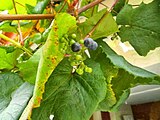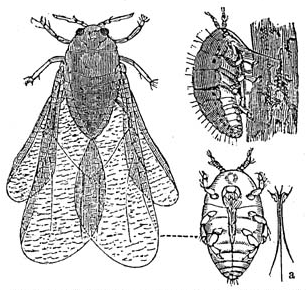
Grape phylloxera is an insect pest of grapevines worldwide, originally native to eastern North America. Grape phylloxera ; originally described in France as Phylloxera vastatrix; equated to the previously described Daktulosphaera vitifoliae, Phylloxera vitifoliae. The insect is commonly just called phylloxera.

Berberis aquifolium, the Oregon grape or holly-leaved barberry, is a species of flowering plant in the family Berberidaceae, native to western North America. It is an evergreen shrub growing 1–3 meters tall and 1.5 m (5 ft) wide, with pinnate leaves consisting of spiny leaflets, and dense clusters of yellow flowers in early spring, followed by dark bluish-black berries.

Vitis vinifera, the common grape vine, is a species of flowering plant, native to the Mediterranean region, Central Europe, and southwestern Asia, from Morocco and Portugal north to southern Germany and east to northern Iran. As of 2012, there were between 5,000 and 10,000 varieties of Vitis vinifera grapes though only a few are of commercial significance for wine and table grape production.
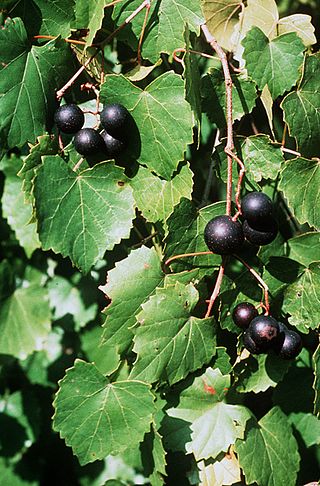
Vitis rotundifolia, or muscadine, is a grapevine species native to the southeastern and south-central United States. The growth range extends from Florida to New Jersey coast, and west to eastern Texas and Oklahoma. It has been extensively cultivated since the 16th century. The plants are well-adapted to their native warm and humid climate; they need fewer chilling hours than better known varieties, and thrive in summer heat.
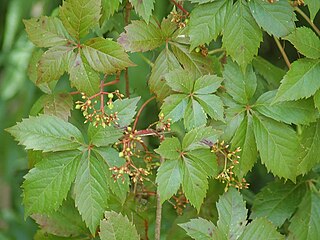
Parthenocissus quinquefolia, known as Virginia creeper, Victoria creeper, five-leaved ivy, or five-finger, is a species of flowering vine in the grape family, Vitaceae. It is native to eastern and central North America, from southeastern Canada and the eastern United States west to Manitoba and Utah, and south to eastern Mexico and Guatemala.

Cornus kousa is a small deciduous tree 8–12 m (26–39 ft) tall, in the flowering plant family Cornaceae. Common names include kousa, kousa dogwood, Chinese dogwood, Korean dogwood, and Japanese dogwood. Synonyms are Benthamia kousa and Cynoxylon kousa. It is a plant native to East Asia including Korea, China and Japan. Widely cultivated as an ornamental, it is naturalized in New York State.

Vitis labrusca, the fox grape, is a species of grapevines belonging to the Vitis genus in the flowering plant family Vitaceae. The vines are native to eastern North America and are the source of many grape cultivars, including Catawba, Concord, Delaware, Isabella, Niagara, and many hybrid grape varieties such as Agawam, Alexander and Onaka. Among the characteristics of this vine species in contrast to the European wine grape Vitis vinifera are its "slip-skin" that allows the skin of the grape berries to easily slip off when squeezed, instead of crushing the pulp, and the presence of tendrils on every node of the cane. Another contrast with European vinifera is the characteristic "foxy" musk of V. labrusca, best known to most people through the Concord grape. This musk is not related to the mammalian fox, but rather to the strong, earthy aromas characteristic of the grapes that were known by early European-American settlers in the New World. The term "foxy" became a sort of catchall for the wine tasting descriptors used for these American wines that were distinct from the familiar flavors of the European viniferous wines.

Vitis riparia Michx, with common names riverbank grape or frost grape, is a vine indigenous to North America. As a climbing or trailing vine, it is widely distributed across central and eastern Canada and the central and northeastern parts of the United States, from Quebec to Texas, and eastern Montana to Nova Scotia. There are reports of isolated populations in the northwestern USA, but these are probably naturalized. It is long-lived and capable of reaching into the upper canopy of the tallest trees. It produces dark fruit that are appealing to both birds and people, and has been used extensively in commercial viticulture as grafted rootstock and in hybrid grape breeding programs.

Vitis rupestris is a species of grape native to the United States that is known by many common names including July, Coon, sand, sugar, beach, bush, currant, ingar, rock, and mountain grape. It is used for breeding several French-American hybrids as well as many root stocks.

Vitis californica, with common names California wild grape, Northern California grape, and Pacific grape, is a wild grape species widespread across much of California as well as southwestern Oregon.

Vitis amurensis, the Amur grape, is a species of grape native to the Asian continent. Its name comes from the Amur Valley in Russia and China.

Vitis mustangensis, commonly known as the mustang grape, is a species of grape that is native to the southern United States. Its range includes parts of Mississippi, Alabama, Louisiana, Texas, and Oklahoma.
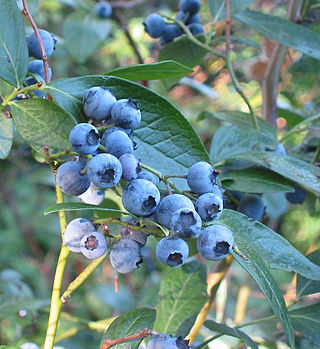
Vaccinium corymbosum, the northern highbush blueberry, is a North American species of blueberry. Other common names include blue huckleberry, tall huckleberry, swamp huckleberry, high blueberry, and swamp blueberry.

Vitis (grapevine) is a genus of 81 accepted species of vining plants in the flowering plant family Vitaceae. The genus consists of species predominantly from the Northern Hemisphere. It is economically important as the source of grapes, both for direct consumption of the fruit and for fermentation to produce wine. The study and cultivation of grapevines is called viticulture.
This glossary of viticultural terms list some of terms and definitions involved in growing grapes for use in winemaking.
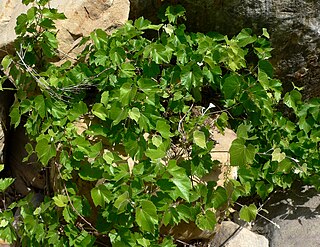
Vitis arizonica is a North American species of wild grape. It is a deciduous vine.
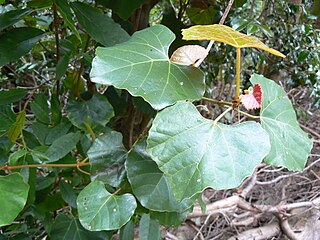
Rhoicissus tomentosa is a vigorous, evergreen vine that is indigenous to the afro-montane forests of southern Africa. It is increasingly popular as an ornamental creeper in gardens, and it has a wide range of uses in traditional medicine.

Acer palmatum, commonly known as Japanese maple, palmate maple, or smooth Japanese maple (Korean: danpungnamu, 단풍나무, Japanese: irohamomiji, イロハモミジ, or momiji,, is a species of woody plant native to Korea, Japan, China, eastern Mongolia, and southeast Russia. Many different cultivars of this maple have been selected and they are grown worldwide for their large variety of attractive forms, leaf shapes, and spectacular colors.

Ampelopsis glandulosa, with common names creeper, porcelain berry, Amur peppervine, and wild grape, is an ornamental plant, native to temperate areas of Asia including China, Japan, India, Nepal, Myanmar, Vietnam, and the Philippines. It is generally similar to, and potentially confused with, grape species and other Ampelopsis species.

Vitis 'Ornamental Grape', also known as ornamental grapevine, Ganzin glory, glory vine and crimson glory, is a nonfruiting ornamental plant that is a hybrid of Vitis vinifera and Vitis rupestris.




